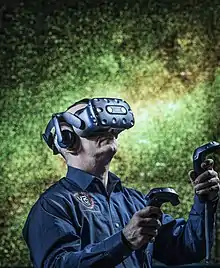Immersive technology
The term immersive technology refers to the technology that is used to create a virtual world for its users. Immersive technology uses a simulated world to create the feel of being in a physical world. This surrounding sensory feeling felt by the user gives the user a sense of immersion in real life setting. The blend of virtual reality and augmented reality is called mixed reality.[1]
%252C_demonstrates_the_Infantry_Immersive_Trainer_(IIT)%252C_one_of_several_Virtual_Training_Environment_projects_(VIRTE).jpg.webp)

Origin
Immersive technology was initially only a work on science fiction. Appearing in futuristic novels and films. "In one of the first short stories to imagine a virtual reality, Pygmalion’s Spectacles, published in 1935, characters wear goggles to experience “a movie that gives one sight and sound…taste, smell, even touch. […] You are in the story, you speak to the shadows, and the shadows reply, and instead of being on a screen, the story is all about you, and you are in it”.[2] The origination of VR technology began in the 1950s using photos and then advanced from there.
Components
A fully immersive, perceptually-real environment will consist of multiple components.
Perception
The following hardware technologies are developed to stimulate one or more of the five senses to create perceptually-real sensations
|
|
|
|
|
Interaction
These technologies provide the ability to interact and communicate with the virtual environment.
Software
"Software interacts with the hardware technology to render the virtual environment and process the user input to provide dynamic, real-time response. To achieve this, software often integrates components of artificial intelligence and virtual worlds. This is done differently depending on the technology and environment; Whether the software needs to create a fully immersive environment or display a projection on the already existing environment the user is looking at.
Research and development
Many universities have programs that research and develop immersive technology. Examples are Stanford's Virtual Human Interaction Lab, USC's Computer Graphics and Immersive Technologies Lab, Iowa State Virtual Reality Applications Center, University of Buffalo's VR Lab, Teesside University's Intelligent Virtual Environments Lab ,Liverpool John Moores University's Immersive Storyl lab ,University of Michigan Ann Arbor, Oklahoma State University and the University of Southern California.[3] All of these universities and more are researching the advancement of the technology along with the different uses that VR could be applied to.[4]
As well universities the video game industry has received a massive boost from immersive technology specifically Augmented reality. The company Epic games known for their popular game Fortnite generated 1.25 billion dollars in a round of investing in 2018 as they have a leading 3D development platform for AR apps.[5] The U.S. Government requests information for immersive technology development[6] and funds specific projects.[7] This is for implementation in government branches in the future.
Application
Immersive technology is applied in several areas, including retail and e-commerce,[8] the adult industry,[9] art,[10] entertainment and video games and interactive storytelling, military, education,[11][12] and medicine.[13] It is also growing in the Non-profit industry in fields such as disaster relief and conservation due to its ability to put a user in a situation that would elicit more of a real-world experience than just a picture giving them a stronger emotional connection to the situation they would be viewing. As immersive technology becomes more mainstream, it will likely pervade other industries. Also with the legalization of cannabis happening worldwide, the cannabis industry has seen a large growth in the immersive technology market to allow virtual tours of their facilities to engage potential customers and investors.
Concerns and ethics
The potential perils of immersive technology have often been portrayed in science fiction and entertainment. Movies such as eXistenZ, The Matrix, and the short film Play by David Kaplan and Eric Zimmerman,[14] raise questions about what may happen if we are unable to distinguish the physical world from the digital world. As the world of immersive technology becomes deeper and more intense this will be a growing concern for consumers and governments alike as to how to regulate this industry. Because all these technology is immersive and therefore not taking place in real life the application and or problems that come with the developing industry are something to keep an eye on. For example, Legal systems debate on topics of Virtual crime, and whether it is ethical to permit illegal behavior such as rape[15] in a simulated environment, this is relative to the adult industry, art, entertainment and video games industries.
References
- Shin, Donghee (September 2019). "How do users experience the interaction with an immersive screen?". Computers in Human Behavior. 98: 302–310. doi:10.1016/j.chb.2018.11.010. ISSN 0747-5632.
- Kershner, John R.; Kershner, Barbara A. (June 1973). "Dual Brain Asymmetry". Academic Therapy. 8 (4): 391–393. doi:10.1177/105345127300800403. ISSN 0001-396X.
- Banna, Srinivasa (2020-04-02). "MicroLED Technology for AR/VR Displays (Conference Presentation)". Optical Architectures for Displays and Sensing in Augmented, Virtual, and Mixed Reality (AR, VR, MR). SPIE. doi:10.1117/12.2566410. ISBN 978-1-5106-3387-2.
- "Top and Best Universities in US for VR / AR". Virtual Reality Augmented Reality Technology Latest News. Retrieved 2020-12-07.
- "The 10 Biggest AR Investments of 2018". Next Reality. Retrieved 2019-11-22.
- "Intelligence Advanced Research Projects Activity (IARPA) RFI". Fbo.gov. 2010-03-12.
- "Army's Telemedicine and Advanced Technology Research Center funds virtual world for amputees". Whatsbrewin.next.gov.com. Archived from the original on 2012-03-05. Retrieved 2010-03-28.
- Petronzio, Matt (April 25, 2013). "Immersing Consumers in 'Immersive Experiences'". Mashable.
- "Porn Industry Embraces Immersive 3D technology". Tgdaily.com.
- "Media Arts and Technology, UC Santa Barbara". Mat.ucsb.edu. Retrieved 20 April 2019.
- "Home - Immersive Education Initiative". Immersiveeducation.org. Retrieved 20 April 2019.
- "Immersive Learning Research Network". Immersive Learning Research Network. Retrieved 20 April 2019.
- "Doctors test new gestural interface during brain surgery". Immersivetech.org. Archived from the original on 2010-06-21. Retrieved 2010-03-28.
- "Archived copy". Archived from the original on 2010-06-25. Retrieved 2010-03-28.CS1 maint: archived copy as title (link)
- "Virtual Rape Is Traumatic, but Is It a Crime?". Wired.com. 4 May 2007.